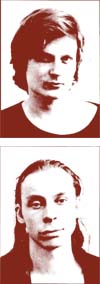|
Index | Historia
| History| Levytykset/Discography | Kuvia
ja Promot/Photos |
|
HISTORY
|
|
Radiopuhelimet, founded in 1986, comes from Oulu, Finland. The band is notorious for aggressive songs, powerful rhythms and original lyrics.
|
|
||
| INTRO 1986-88 1989-90 1990-92 1992-93 1994-95 1995-96 1996-98 1998-2000 2001-2002 |
INTRODUCTION
From autumn 1983 to March 1986 Jarno Mällinen (guitar)
and Jyrki Raatikainen (drums) played in Kansanturvamusiikkikomissio
together with Kansanturvamusiikkikomissio (or KTMK for short) disbanded after
their last show on the first of March 1986. A couple of weeks later
Mällinen, Raatikainen and Kangas formed a new band called Radiopuhelimet
|
||
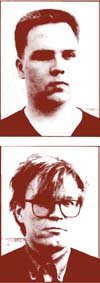 |
(1986-88) FIRST SHOWS AND RECORDINGS The first rehearsal room was located at Leipätehdas (Bread
Factory) which was at the time the hotspot of music and non-professional
theatre scene in Oulu. The first five-song demo tape by Radiopuhelimet was finished late
in the autumn of the same year and received positive comments in
rock magazine Rumba. In the following spring the band looked for
a new bass player after Kangas - who had played bass guitar until
then - announced his desire to play guitar instead. Mika Hautamäki,
a well-known face from the Oulu band scene, accepted the post and
the new outfit played its first show on 3.4.1987 at Jyrock festival.
|
||
|
FIRST RELEASES During autumn 1987 Raatikainen, Antti Penttilä and Kari Heikonen founded a record company called Bad Vugum with the intention of publishing music by Radiopuhelimet. The band immediately recorded eight songs which were released as two 7" EP's: Sinappia ja ketsuppia ("Mustard and ketchup"), released right before christmas in 1987 and Tyhjä on täysi ("Empty is full") in spring 1988. The recordings brought Radiopuhelimet to the attention of record company Euros and a deal for two full-length albums was signed. The first album, Rokkiräjähdys ("Rock explosion") was recorded during the early weeks of autumn 1988 and was released a couple of months later. The reviews were mostly positive.
|
|||
| (1989-90) NEW LINE-UP & NEW RECORD COMPANY - K.O. Rehearsals of new material had been underway for some time when
bass player Hautamäki announced This five-man line-up played its final show in Tampere in August 1989. Hautamäki settled in Helsinki and Kangas returned to bass-playing. The next album, K.O., recorded in October 1989 was recorded with a four-man line-up (Kangas also plays second guitar on the record). Meanwhile the record company had changed to Spirit, a sublabel of Sonet, piloted by Riku Mattila. Euros was no longer interested in Radiopuhelimet, probably because sales were not what the company had expected and because the band refused to sign publishing contracts. Euros gave the band willingly away to Spirit. Mattila also recorded and produced the album. The final sound mix was done by Mikko Karmila (but went uncredited).
|
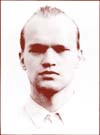
|
||
| INTRO 1986-88 1989-90 1990-92 1992-93 1994-95 1995-96 1996-98 1998-2000 2001-2002 |
LENINGRAD & DOUBLE KORHONEN Right on the eve of the K.O. recording sessions Radiopuhelimet
played their first shows abroad in Leningrad (now St. Petersburg).
The venues were a small youth club somewhere in the suburbs with
a small but enthusiastic audience and a grandiose youth palace At the end of 1989 a new bass player Eero Korhonen joined
the band and was injured in a traffic accident right away: his vicissitudes
with the band started with a K.O. was published in February 1990. The album was received with
enthusiasm and the band got to play more shows than before. Hannu
Korhonen had replaced Jussi Alavuotunki (r.i.p.) as the
promoter. Later on Korhonen was employed by an agency called Dex-Viihde
("Dex Entertainment") and Radiopuhelimet went with him.
During the summer of 1990 the band performed in Ruisrock, Dinosaurock,
Suviyön sumutus and Nummirock.
|
||
| (1990-92) PIAN PIAN AND 2 1/2 Recording sessions for a new album started in September 1990 in
an old factory building on Pikisaari island in Oulu. Riku Mattila
was again recording and producing it. After a couple of shows played
after the recording sessions the band went on a half-year The new album, entitled Pian, pian ("Soon, soon"), was published when Raatikainen returned in spring 1991. Although it received a mostly positive response from the papers there was some dissatisfaction especially on the part of the audience. Shows were nevertheless successful,even though there were no gigs on big festivals in the summer. A compliation album called 2 1/2 was released in autumn 1991 and
received a much better reaction. It contained the two first EP recordings
and five songs off the first album. (It should be mentioned here
that the sound mix differs significantly from the original recordings.
This is caused by the engraving method employed by the German record
pressing plant. There are also two sound-wise completely different
versions of Pian, pian around: the CD sounds very dry and un-rock
while the full and rich distortion of the LP is almost "too
full". The reason for the differences is a last-minute decision
made by producer Mattila to put the whole album through whatever
compressor - the last-minute change just didn't make it to the CD
version in time.)
|
|||
| INTRO 1986-88 1989-90 1990-92 1992-93 1994-95 1995-96 1996-98 1998-2000 2001-2002 |
(1992-93) THE ARCTIC OCEAN AND EUROPE A new album, Jäämeri ("The Arctic Sea") was
recorded in January 1992. The sessions were much more meticulous
and diligent in comparison with earlier In February Radiopuhelimet left for their first longer tour abroad
together with CMX. Almost 20 shows were played in a five
weeks' time in Germany, Austria, Italy and Denmark. The reception
was very good and there Jäämeri was released in April '92 to a somewhat confused audience. Many people didn't know how to react to the music which had slowed down and gained a "jerky" quality: the album was "interesting" but "difficult". It did, however, find understanding among friends of jazz/avantgarde music, even to the extent that some people still consider it to be the best recording the band has ever made. During the spring of 1992 Veda Honkanen (r.i.p.) , who was
believed to handle independent and international connections better
than Hannu Korhonen who had moved to a biggest agency, became the
new promoter. The decision was proved right as Veda put his whole
heart to the task.
|
||
|
ON THE COUNTRYSIDE The remaining part of 1992 was spent playing domestic shows and rehearsing new material. A new album was recorded in the spring of 1993. During the summer Mikko Karmila mixed parts of it again and the album, entitled Maalla ("On the Countryside") was released in October. Meanwhile the band played some gigs. In the autumn Radiopuhelimet participated in a Kari Peitsamo (an old finnish rock'n'roll star) tribute night, playing some songs by Peitsamo. Voima ("Force") remained in the live set for a while. After two albums that were regarded more or less difficult to approach the more straightforward Maalla was received with enthusiasm and got the bandall time top scores in the yearly audience polls of rock magazines at the end of the year.
|
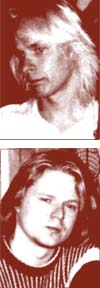 |
||
| INTRO 1986-88 1989-90 1990-92 1992-93 1994-95 1995-96 1996-98 1998-2000 2001-2002 |
(1994-95) ANNUNEN JOINS AS BASS PLAYER & BAND PLAYS SHOWS ABROAD The band and bass player Korhonen parted ways in December 1993
due to his other commitments which made touring and intense rehearsing
impossible. The initial plan was to have Annunen as a bass player only for
the tour and return to a four-man line-up again, but things worked
out so well that the final show of the tour in the Seamen's Mission
in Hamburg was not his The tour lasted for five weeks and included shows in Sweden, Norway,
Denmark, Germany, Hungary and the Czech Republic. The summer was
spent playing shows at Finnish festivals. At the end of the year
there was a
|
||
|
BACK HOME - HYGIENE TO AMERICA - EARTH RADIATION At the beginning of 1990 the band returned to Bad Vugum. Sonet/Spirit
had by the time of Jäämeri album become a part of multinational
PolyGram entertainment corporation. Profit was to be made and "hobbyists"
like There had been plans for moving to another label in the air already. They were mostly caused by the increasingly indifferent and inflexible attitude on the part of Polygram. Especially getting release rights for a couple of songs to be included on an Alternative Tentacles compilation EP called "Hygiene" was difficult to say the least. Even though there was less money at Bad Vugum there were little
real changes - the biggest minus was the absence of luxurious dinners
after recording sessions. Riku Mattila promised to supervise recording
sessions New material had been tested and rehearsed on the gigs as usual
and a new album, Maasäteilyä (Earth radiation) was recorded
in February 1995. When it came out just before summer the reviews
were the best since K.O.
|
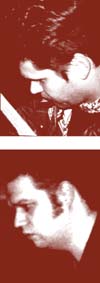 |
||
| INTRO 1986-88 1989-90 1990-92 1992-93 1994-95 1995-96 1996-98 1998-2000 2001-2002 |
(1995-96) ICELAND CALLING & A NEW GUITARIST STEPS IN During easter '95 the band made a trip to Reyjavik, Iceland. During a week's stay the band got to know the city and the stunning nature of Iceland. They also played two shows at rock club Tveim Vinir - another testimony to the fact that their musical appeal was not constrained by language barriers: the audience was very enthusiastic, as it usually was on gigs abroad. The summer went by with the band playing the usual festival shows and the rest of the year was spent rehearsing new material and playing some more shows. At the beginning of 1996 guitar player Kangas left the band due
to work commitments and family reasons. The second guitarist Mällinen
immediately phoned Ray Katz, the singer-guitar player from
Electric Blue Peggy Sue,
|
||
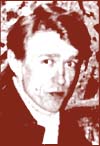 |
(1996-98) EUROPE, SPACE AND KOSTAMUS-SYMPHONY Rehearsal with Katz started in February 1996 and in April the band left for an almost-three-week tour of Europe with ten shows in Denmark, Germany, Belgium and the Netherlands. Besides the tour, Katz entry into the band was helped by the fact that most of the new material had been finished with Kangas and was ready. After the festival shows in summer new recording sessions began in September. Riku Mattila couldn't make it to the sessions this time so Mikko Karmila recorded, produced and mixed the new album. The material was put on hold to wait for the final mix when the band left to Helsinki for five weeks. They performed in Kostamus-symphony, the 70-year jubilee play of the University Student Theatre. The play, directed by Esa Kirkkopelto, received a fair amount of publicity and all 11 official performances were filled to the last seat. An abridged version of the play was televised in December. Immediately after the final performance of the play, mixing sessions
for the new album to be called Avaruus (Space) began. Since the
new line-up the overall sound of the band had become "dry"
and the result was not
|
||
|
SPECIAL SHOWS, SADNESS AND SILENT! In the summer the band played festival shows again: Ruisrock, Ilosaarirock, Tammerfest, Down by the Laituri and Läsnärock. In DBTL and Läsnärock they played, in addition to the normal set, a special "reggae set" featuring a selection of songs rearranged into reggae and ska rhythms. Another specialty was as an acoustic version of Syksyn valo (Autumn light) performed at the end of the summer for MTV3's music show Jyrki. Veda Honkanen passed away at the end of June after six months of
illness. Sami Häikiö from the band Karkkiautomaatti
became the new promoter but New material had been rehearsed in between the few shows the band had, and a new album Hiljaista! (Silent!) was recorded in July with the assistance of Riku Mattila as usual. Pentti Dassum (from Deep Turtle, etc) was hired as a new studio worker. Among the festival shows of summer 1998 a special set of old Kansanturvamusiikkikomissio songs was played in Läsnärock with a four-man line-up (without Katz). The KTMK set was performed also in Oulu in December. Hiljaista!, mixed by Mikko Karmila, was released in September. It received mostly positive comments but also caused some surprise because of its slow and "airy" quality formerly quite uncharacteristic of the band.
|
|||
| INTRO 1986-88 1989-90 1990-92 1992-93 1994-95 1995-96 1996-98 1998-2000 2001-2002 |
(1998-2000) A PLAY CALLED RADIOPUHELIMET AND A CITY CALLED OULU Theatre director Juha Hurme, who the band had got to know while working on Kostamus-symphony, had already in summer '97 suggested a play to be produced in collaboration. The project started in spring 1998 with group discussions and interviews of various band members made by Hurme. Constructing and rehearsing the script went on little by little until the play, called simply "Radiopuhelimet", premiered at the Oulu Children's Theatre Festival in February 2000. During the rest of the year the play was performed around Finland in connection with ordinary gigs. The reception was excellent everywhere: the audience seemed to like the play more than the music itself. A good example of this was one fan letter addressed "to a band I don't like". A Radiopuhelimet magazine, edited by the members of the band, was also published at the premiere of the play. The magazine was for sale at play performances and gigs. It contains childhood memories of band members, stories from the gigs and other nonsense. A new album, Oulu on kaupungin nimi (Oulu is the name of a city) was recorded in December 1999. Riku Mattila and Pentti Dassum worked at the studio again and Mikko Karmila mixed the album. The album was released in April 2000 and marks a return to the more noisy and upbeat songs of the early albums. It received the best reviews since Maasäteilyä. For the first time in history the band took it easy after recording
the new album and didn't start rehearsing new material until summer
2000. TODAY! New songs were refined at gigs for more than a year and the band entered the studio (this time a real one) in Oulu just before Christmas 2001. Riku Mattila and Pentti Dassum recorded the album and it was mixed at Finnvox studios in Helsinki by Mikko Karmila and Jarno Mällinen. The record, entitled Tänään! (Today!) was released in April 2002 under a new label Hot Igloo. |
||
Index | Historia
| History| Levytykset/Discography | Kuvia
ja Promot/Photos |
Keikat/Gigs | Uutisia/News
| ktmk | Audio&Video
